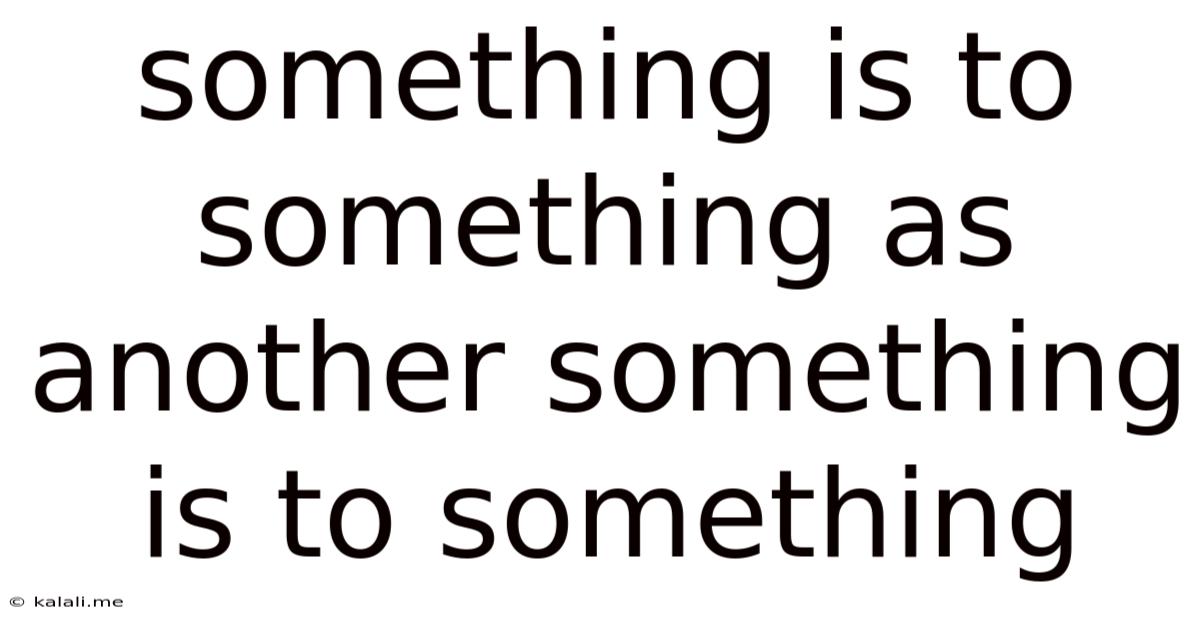Something Is To Something As Another Something Is To Something
Kalali
Jun 10, 2025 · 3 min read

Table of Contents
Mastering the Analogy: Something is to Something as Another Something is to Something
Analogies are powerful tools. They bridge the gap between the familiar and the unfamiliar, making complex ideas easier to grasp and enhancing our understanding of the world. This simple yet effective structure – "Something is to Something as Another Something is to Something" – forms the backbone of many analogies, and mastering it can significantly improve your communication and problem-solving skills. This article will explore how to construct, understand, and utilize this fundamental analogical structure effectively. We'll delve into its application in various contexts, from everyday conversations to complex academic arguments.
This article will cover:
- Understanding the Structure: Deconstructing the fundamental components of the analogy.
- Identifying Relationships: Exploring the various types of relationships analogies can represent.
- Constructing Effective Analogies: Tips and techniques for creating strong and persuasive analogies.
- Using Analogies in Different Contexts: Examples of analogy use in writing, presentations, and problem-solving.
- Avoiding Common Pitfalls: Recognizing and correcting flaws in analogical reasoning.
Understanding the Structure: A is to B as C is to D
The basic structure is straightforward: A has a specific relationship to B, and C has the same relationship to D. This relationship can be anything from cause and effect to part-to-whole, or even more abstract concepts. For example:
- Hot is to Cold as Up is to Down: Here, the relationship is antonymy (opposites).
- Wheel is to Car as Tire is to Bicycle: Here, the relationship is a part-to-whole relationship. A wheel is a part of a car, and a tire is a part of a bicycle.
- Doctor is to Patient as Teacher is to Student: This analogy highlights a professional-client relationship.
Identifying Relationships: The Key to a Successful Analogy
The strength of an analogy rests on the clarity and precision of the relationship between the terms. Understanding the type of relationship is crucial. Some common relationships include:
- Synonyms: Happy is to Joyful as Sad is to Sorrowful
- Antonyms: Large is to Small as Fast is to Slow
- Part-to-Whole: Branch is to Tree as Leaf is to Plant
- Cause-and-Effect: Fire is to Smoke as Rain is to Puddle
- Function: Hammer is to Nail as Screwdriver is to Screw
Constructing Effective Analogies: Tips for Clear Communication
Crafting compelling analogies requires careful consideration. Here are some tips:
- Choose Familiar Concepts: Use terms that your audience readily understands.
- Maintain Consistency: Ensure the relationship between A and B mirrors the relationship between C and D precisely.
- Keep it Concise: Avoid overly complex or lengthy analogies that might confuse your audience.
- Consider your Audience: Tailor the analogy to their knowledge and understanding.
Using Analogies in Different Contexts: From Everyday Life to Academic Discourse
Analogies find applications in numerous situations:
- Explaining Complex Ideas: Breaking down difficult concepts into easily understandable terms.
- Persuasive Arguments: Using relatable examples to support your claims.
- Problem-Solving: Drawing parallels to similar problems and solutions.
- Creative Writing: Adding depth and richness to your narratives.
Avoiding Common Pitfalls: Recognizing Flawed Analogies
Not all analogies are created equal. Be wary of:
- False Equivalencies: Drawing comparisons that are superficial or inaccurate.
- Oversimplification: Ignoring crucial differences between the compared elements.
- Weak Relationships: Using relationships that are too vague or unclear.
Mastering the art of analogy requires practice and careful consideration. By understanding its structure, identifying relationships, and avoiding common pitfalls, you can effectively leverage this powerful tool to communicate ideas, solve problems, and enhance your understanding of the world around you.
Latest Posts
Latest Posts
-
How Much Oz In A Bottle Of Water
Jul 01, 2025
-
How Long Does It Take To Drive 10 Miles
Jul 01, 2025
-
How Many 9s Are In A Deck Of Cards
Jul 01, 2025
-
How Many Pounds Are In 2 5 Kg
Jul 01, 2025
-
Which Is Greater 2 3 Or 2 4
Jul 01, 2025
Related Post
Thank you for visiting our website which covers about Something Is To Something As Another Something Is To Something . We hope the information provided has been useful to you. Feel free to contact us if you have any questions or need further assistance. See you next time and don't miss to bookmark.